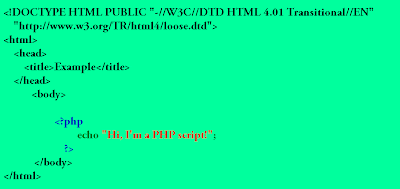PHP originally stood for personal home page. It was introduce way back in 1994 as a set of Common Gateway Interface (CGI) binaries written in the C programming language.
Simple PHP beginner example
PHP is a general-purpose scripting language that is especially suited to server-side web development where PHP generally runs on a web server. Any PHP code in a requested file is executed by the PHP runtime, usually to create dynamic web page content. It can also be used for command-line scripting and client-side GUI applications. PHP can be deployed on most web servers, many operating systems and platforms, and can be used with many relational database management systems. It is available free of charge, and the PHP Group provides the complete source code for users to build, customize and extend for their own use.
PHP primarily acts as a filter,taking input from a file or stream containing text and/or PHP instructions and outputs another stream of data; most commonly the output will be HTML. Since PHP 4, the PHP parser compiles input to produce byte code for processing by the Zend Engine, giving improved performance over its interpreter predecessor.
PHP was originally designed to create dynamic web pages, but now PHP focuses mainly on server-side scripting, and it is similar to other server-side scripting languages that provide dynamic content from a web server to a client, such as Microsoft's Active Server Pages, Sun Microsystems' JavaServer Pages, and mod_perl. PHP has also attracted the development of many frameworks that provide building blocks and a design structure to promote rapid application development (RAD). Some of these include CakePHP, Symfony, CodeIgniter, and Zend Framework, offering features similar to other web application frameworks.
The LAMP architecture has become popular in the web industry as a way of deploying web applications. PHP is commonly used as the P in this bundle alongside Linux, Apache and MySQL, although the P may also refer to Python or Perl or some combination of the three.
A new major version has been under development alongside PHP 5 for several years. This version was originally planned to be released as PHP 6 as a result of its significant changes, which included plans for full Unicode support. The new version is set to remove many old features such as the removal of register globals, magic quotes, and safe mode.The reason for the removals was that register_globals had given way to security holes, and magic quotes had an unpredictable nature, and was best avoided. Instead, to escape characters, magic quotes may be substituted with the addslashes() function, or more appropriately an escape mechanism specific to the database vendor itself like mysql_real_escape_string() for MySQL.




1 comments:
Excellent about PHP. nice post. thanks for sharing .
Post a Comment